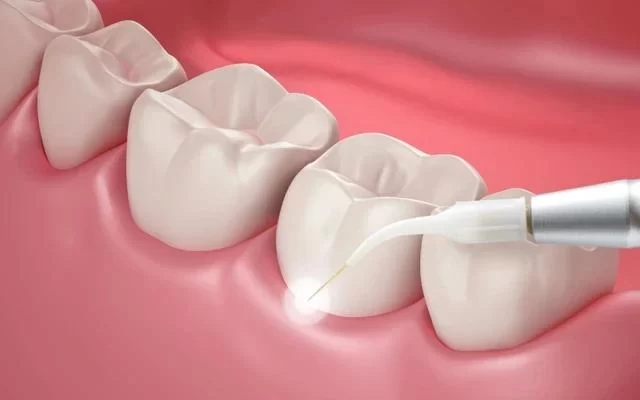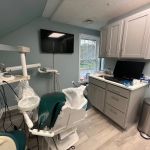
Laser Treatment for Gum Disease: A Revolutionary Solution for Gum Health
- What is Laser Treatment for Gum Disease?
- Benefits of Laser Therapy for Gum Disease
- How Does Laser Treatment Work for Gum Disease?
- Who is a Good Candidate for Laser Gum Treatment?
- Aftercare and Recovery from Laser Gum Treatment
What is Laser Treatment for Gum Disease?
Laser treatment for gum disease is a cutting-edge dental procedure that uses focused light energy to remove infected tissue and promote healing in the gums. It's often used for treating periodontal disease, which affects the tissues surrounding the teeth. Traditional treatments for gum disease, such as scaling and root planing, can be uncomfortable and invasive. However, laser gum treatment provides a less invasive, faster, and more precise alternative to improve gum health.
Laser therapy is highly effective at targeting bacteria, removing inflamed tissue, and reducing the depth of gum pockets, all of which are key factors in gum disease. This method is known as laser periodontal therapy, and it has become increasingly popular due to its minimal discomfort and quick recovery times.
Benefits of Laser Therapy for Gum Disease
There are numerous benefits to choosing laser treatment for gum disease. This innovative therapy not only addresses the root causes of gum disease but also provides a more comfortable experience for patients. Below are some of the key advantages of laser gum disease treatment:
1. Precision and Accuracy
Unlike traditional methods, laser therapy offers exceptional precision, targeting only the infected or damaged tissues while leaving healthy tissue untouched. This minimizes damage to surrounding areas, allowing for more focused treatment and better overall results.
2. Minimal Discomfort
One of the most attractive benefits of laser gum disease treatment is that it is generally less painful than conventional surgery. The laser's light energy can help seal blood vessels and nerve endings as it works, reducing bleeding and discomfort. Many patients report a much more comfortable experience compared to traditional gum surgery.
3. Faster Recovery Time
Recovery from laser gum treatment is typically faster than from traditional procedures. Because the laser minimizes damage to surrounding tissues and helps in the natural healing process, patients usually experience less swelling, bleeding, and discomfort. Most people are able to resume their normal activities within a few days.
4. Reduced Risk of Infection
The laser's heat energy helps kill bacteria and sterilize the treated area, which reduces the risk of infection. This is a major advantage, especially for individuals who may be prone to infections or have weakened immune systems.
5. Long-Lasting Results
When performed correctly, laser treatment can provide long-lasting improvements in gum health. By addressing the infection at its source and promoting tissue regeneration, laser therapy can significantly improve gum health and help prevent future problems.
How Does Laser Treatment Work for Gum Disease?
Laser gum disease treatment works by utilizing a highly focused beam of light to target and remove infected gum tissue. The procedure is typically performed under local anesthesia to ensure comfort. Here's a breakdown of the laser gum treatment process:
1. Consultation and Diagnosis
Before undergoing laser therapy, you will have a thorough consultation with your dentist. During this appointment, your dentist will assess the severity of your gum disease, check for any underlying health conditions, and determine whether laser treatment is the right solution for you.
2. Application of Local Anesthesia
To ensure comfort, local anesthesia will be applied to the treatment area. This ensures that you do not feel pain during the procedure. In some cases, your dentist may use a mild sedative if you're feeling particularly anxious about the treatment.
3. Targeted Laser Treatment
Once you're numb, the dentist uses a specialized dental laser to remove the infected tissue and bacteria from your gums. The laser also works to clean the root surfaces of your teeth, helping to promote healing and reduce inflammation. The entire process typically takes about 30 minutes to an hour, depending on the extent of the gum disease.
4. Post-Treatment Care
After the procedure, you may experience some mild discomfort, but it usually subsides within a few days. Your dentist will provide specific aftercare instructions to help you manage any post-treatment symptoms and ensure proper healing.
Who is a Good Candidate for Laser Gum Treatment?
Laser gum disease treatment is suitable for most individuals who have mild to moderate gum disease. It's especially beneficial for people who are looking for a less invasive option to treat their condition. However, there are certain factors that may make someone a better candidate for laser therapy:
1. Mild to Moderate Gum Disease
Laser therapy is most effective in cases of mild to moderate gum disease. If you have severe gum disease, your dentist may recommend a combination of treatments, including laser therapy, to achieve the best results.
2. Preference for Minimally Invasive Treatments
If you are seeking a treatment option with minimal discomfort and a quicker recovery time, laser therapy is an excellent choice. It’s ideal for individuals who want to avoid more invasive procedures like traditional gum surgery.
3. Health Considerations
People with certain health conditions, such as diabetes or heart disease, may benefit from laser treatment since it minimizes trauma and reduces the risk of complications. Always consult with your dentist to determine if laser therapy is right for you.
Aftercare and Recovery from Laser Gum Treatment
Recovery from laser gum treatment is typically quick and uncomplicated. Since the procedure is minimally invasive, most patients experience little downtime. Here's what you can expect after your treatment:
1. Manage Pain and Swelling
Some mild discomfort, swelling, or tenderness may occur after the procedure, but this usually resolves within a few days. Over-the-counter pain relievers can help manage any discomfort.
2. Maintain Good Oral Hygiene
It’s essential to keep your mouth clean after the treatment. Your dentist will advise you on how to brush and floss around the treated areas to avoid infection while promoting healing.
3. Follow-Up Appointments
You may need to schedule follow-up appointments with your dentist to monitor your healing progress and ensure that the treatment is effective. Regular check-ups will help maintain the health of your gums.
Laser treatment for gum disease is an excellent choice for those seeking a safe, effective, and less invasive solution for gum health. If you're dealing with gum disease and want to explore laser therapy, visit Dentistry Toothtruth to learn more about your options and schedule a consultation.







 Seung H. Baek, DDS, Inc.4.0 (19 review)
Seung H. Baek, DDS, Inc.4.0 (19 review) Graylyn Dental4.0 (681 review)
Graylyn Dental4.0 (681 review) David M. Wolf DDS, PC5.0 (298 review)
David M. Wolf DDS, PC5.0 (298 review) Village Dental Center5.0 (393 review)
Village Dental Center5.0 (393 review) Tranquil Dental4.0 (372 review)
Tranquil Dental4.0 (372 review) Duxbury Dental4.0 (71 review)
Duxbury Dental4.0 (71 review) The Importance of Oral Health Education During Pregnancy for a Healthy Pregnancy
The Importance of Oral Health Education During Pregnancy for a Healthy Pregnancy Best Tips for Brushing Your Teeth Properly for Healthy Gums: Essential Techniques for Oral Health
Best Tips for Brushing Your Teeth Properly for Healthy Gums: Essential Techniques for Oral Health Why Skipping Dental Checkups Can Lead to Bigger Oral Health Problems
Why Skipping Dental Checkups Can Lead to Bigger Oral Health Problems Advantages of Porcelain Dental Restorations
Advantages of Porcelain Dental Restorations How Can Diabetes Cause Tooth and Gum Problems? Preventing and Managing Oral Health Issues
How Can Diabetes Cause Tooth and Gum Problems? Preventing and Managing Oral Health Issues Healthy Habits for Promoting Good Oral Health and Hygiene: Tips for a Healthy Smile
Healthy Habits for Promoting Good Oral Health and Hygiene: Tips for a Healthy Smile